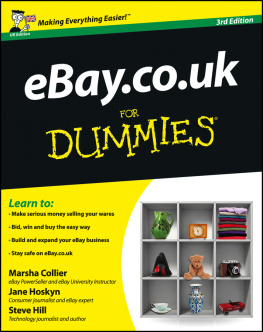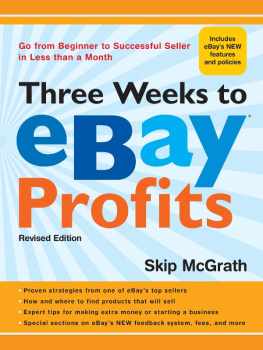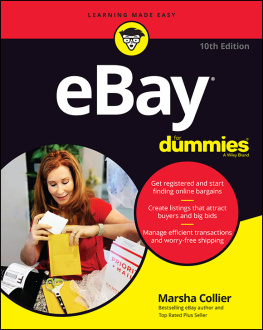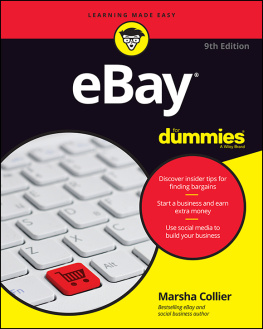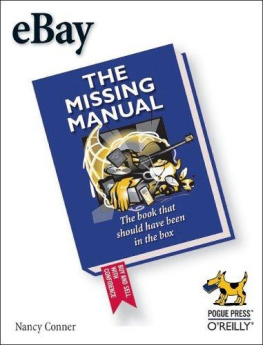1.1 Hacks #1-8
eBayis a community of buyers and sellers, not just a mere web site orpiece of software. It's a complex social system ofwhich you are an active member. Success on eBay depends not only onyour ability to master the technical tasks of bidding and selling,but on your ability to communicate with other eBay members and yourwillingness to contribute to the community in a positive way.
Feedback is the basis of trust on eBay. Each eBay member has his orher own feedback profile, a public collection of comments left byother eBay members. Each individual feedback comment is tied to atransaction in which the particular member took part.Feedbackcomments are marked either positive, negative, or neutral, and areadded accordingly in the summary that appears at the top of the page.
A member's feedbackrating is the number representing the sum of all positive comments, minusthe sum of all negative comments. (Note, however, that multiplecomments left by a single user will never count more than one point.)This number, shown in parentheses after a member'suser ID, is a useful tool in determining the trustworthiness andexperience level of any given eBay member.
 | It's important to note that the feedback ratingalone does not give you a sufficient picture of anymember's personal history. Before you do businesswith any other member, make sure to click on the feedback rating toview the member's feedback profile as a whole. |
|
Feedback is taken very seriously on eBay, and with good reason. Forexample, a seller who deals honestly and fairly with his or hercustomers will earn lots of positive feedback over the years.Conversely, dishonest or unreliable sellers and deadbeat bidders arelikely to earn a higher percentage of negative feedback.
1.1.1 Leaving Feedback
You can leavefeedbackfor another member only if you are both involved in a transaction,namely a completed auction. The actual task of leaving feedback isquite simple; simply go to the completed auction page and click LeaveFeedback. Choose a rating (positive, neutral, or negative) and type a"review" in the space provided.You'll then have 80 characters in which to explainwhat the other eBay member did right (or wrong).
Here are some guidelines for writing appropriate feedback:
Positive. As long as a transaction goes reasonably well, you should alwaysleave positive feedback for the other party.
If you're a bidder, you'll want toreward the seller for shipping quickly, responding to questionspromptly, and describing the item accurately; for example:
"Quick shipping, great deal, overall friendlyservice. A credit to eBay."
"Item better than described; trustworthy seller.Highly recommended!"
As a seller, you'll likewise want to leave positivefeedback for bidders who pay right away.
"Lightning-fast payment. Reliable buyer. Thanks foryour business!"
"Quick to pay, friendly emails. This eBayer makesselling a pleasure!"
Negative. Negative feedback is unfortunately overused on eBay, and is, in mostcases, unnecessary.
 | If at all possible, try to resolve the problem with the other partyinstead of leaving negative feedback. If you're abuyer, for example, and you're not happy with thetransaction, contact the seller to see if he or she will make itright before you give up and post negative feedback. Not only willyou avoid possible feedback retaliation, but you might stand to getsome money out of it as well. |
|
As a bidder, you should leave negative feedback only if you paid andnever received the item, if the seller misrepresented the item anddid not offer a refund, or if the seller defrauded you in some way.(Note that unless the seller is also the manufacturer of the item, it'snot fair to leave negative feedback simply because youdon't like the item you purchased. And remember, youcan always resell the item if you're not happy.)
If you're a seller, you should leave negativefeedback only for deadbeat bidders who don't pay.(It's not acceptable to penalize a bidder forreturning an item as a result of your mistake.) For example:
Neutral. While neutral comments don't affect the feedbackrating, they carry the stigma of a complaint. For this reason, leaveneutral feedback only when you have a legitimate complaint butcan't bring yourself to leave negative feedback. Forexample, neutral feedback might be appropriate for a bidder whorepeatedly does not follow payment instructions, or a seller whopacks an item so poorly that it arrives damaged. A few examples:
"Poor packing job, shipping took a long time. Sellerslow to respond."
"Condition wasn't great; seller toobusy to care. Not recommended."
"Bidder took a month to send payment; not responsiveto emails."
Overall, remember the purpose of thefeedback system when writing feedback foranother member. The point of negative and neutral comments is toserve as warnings to other eBay members and to help show a pattern ofmisconduct. Unless the other person caused you a real problem or costyou money unnecessarily, your feedback comment should be positive andshould reward the person for what they did right.Don't use negative or neutral feedback frivolously;for example, don't dock a seller for putting amailing label on crooked.
Finally, never use feedback as a means of coercion, anddon't let other eBay members blackmail you bythreatening to leave negative feedback. Any buyer or seller who letsanother member get away with murder simply because theydon't want that person to retaliate with negativefeedback does the entire eBay community a disservice.
1.1.2 Deciphering Feedback
As you use eBay, you'll constantly be reviewingother members'feedback profiles, soit's important to interpret the numbers properly.What it usually comes down to is determining a pattern of behaviorfrom the bits and pieces of past transactions.
At the top of a feedback profile page, eBay shows a summary anddistribution of past feedback comments, as shown in .
Figure 1-1. The Summary of Most Recent Reviews gives a picture of another member's feedback history
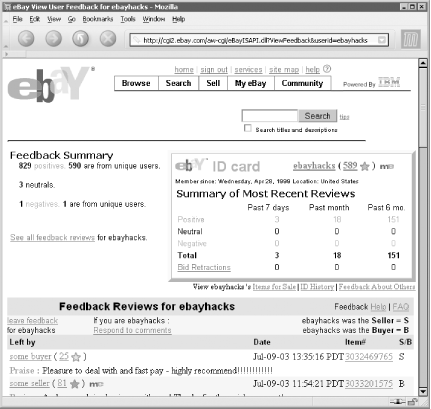
Here you'll see the number of positive, negative,and neutral comments, as well as how many of each were received bythe user in the past seven days, the past month, and the past sixmonths. Among other things, this helps add a little perspective toolder entries, especially negative ones.
For example, before you bid on any auction, you'llwant to check out the seller's feedback. A givenseller might have 140 positive comments and 3 negative comments,while another seller might have 612 positive comments and only 2negative comments. Is the second seller necessarily better than thefirst? What if both of his negative comments were received in thepast week?
On the auction page, a seller's standard feedbackrating is supplemented with a "positivefeedback" percentage, which is calculated bydividing the number of positive comments by the total number ofpositive and negative comments. Note that since neutral comments arenot part of the equation, a seller with 34 positive comments and 8neutral comments will have a seemingly perfect positive feedbackpercentage of 100%. But does this percentage mean this seller is moretrustworthy than the aforementioned sellers, with positive feedbackpercentages of 97.9% and 99.7%, respectively? Of course not.


